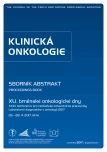Diagnostic and Therapeutic Potential of Membrane HSP90
Authors:
O. Vacek; M. Pastorek; M. Ďurech; B. Vojtěšek; P. Müller
Authors‘ workplace:
RECAMO, Masarykův onkologický ústav, Brno
Published in:
Klin Onkol 2017; 30(Supplementum1): 191-194
Category:
Article
Overview
Background:
Heat shock protein (HSP90) is a molecular chaperone involved in maintaining protein homeostasis by modulating stability of de novo synthesized proteins. Neoplastic cells with high metabolic rate have higher expression of HSP90 and develop so called “chaperone addiction”. Specific inhibition of HSP90 has been therefore discussed as a viable therapeutic strategy and several inhibitors of HSP90 have already entered clinical trials. Recently, a novel role for HSP90 was found on plasma membrane of cancer cells. Since then, extracellular HSP90 has been implicated in increased tumor invasiveness and metastasis, but better understanding of its regulation is needed to fully explore its potential in early detection of malignity and import of specific HSP90 inhibitors. We have therefore analyzed correlation of extracellular HSP90 level with import of fluorescently-labeled inhibitor of HSP90 and total expression of HSP90.
Methods:
Flow cytometry was used to analyze cell uptake of FITC-Geldanamycin as well as level of extracellular HSP90, while total expression of HSP90 was analyzed by SDS-PAGE and subsequently Western blotting. Data was then subjected to statistical analysis to analyze possible correlation.
Results:
We have analyzed import of fluorescently labeled HSP90 inhibitor together with total and membrane level of HSP90 on a panel of selected breast carcinoma cell lines (BT-474, BT-549, BT-20, MCF-7, MDA-MB-468, SK-BR-3 a T-47D). Acquired data were subjected to statistical analysis that revealed a correlation between total and membrane level of HSP90 as well as correlation of ectopic HSP90 with uptake of HSP90 inhibitor.
Conclusions:
Our analysis has shown that import of HSP90 inhibitors is likely dependent on membrane level of HSP90 as well as its total expression, and therefore can potentially reflect HSP90 addiction of cancer cells.
Key words:
breast neoplasms – HSP90 – heat shock proteins – geldanamycin
This work was supported by MEYS – NPS I – LO1413.
The authors declare they have no potential conflicts of interest concerning drugs, products, or services used in the study.
The Editorial Board declares that the manuscript met the ICMJE recommendation for biomedical papers.
Submitted:
13. 3. 2017
Accepted:
26. 3. 2017
Sources
1. Ferrarini M, Heltai S, Zocchi MR et al. Unusual expression and localization of heat-shock proteins in human tumor cells. Int J Cancer 1992; 51 (4): 613–619.
2. Ruckova E, Muller P, Nenutil R et al. Alterations of the Hsp70/Hsp90 chaperone and the HOP/CHIP co-chaperone system in cancer. Cell Mol Biol Lett 2012; 17 (3): 446–458. doi: 10.2478/s11658-012-0021-8.
3. Devarakonda CV, Kita D, Phoenix K et al. Patient-derived heavy chain antibody targets cell surface HSP90 on breast tumors. BMC Cancer 2015; 15 (1): 614. doi: 10.1186/s12885-015-1608-z.
4. Chiosis G, Neckers L. Tumor selectivity of Hsp90 inhibitors – the explanation remains elusive. ACS Chem Biol 2006; 1 (5): 279–284.
5. Kamal A, Boehm MF, Burrows FJ. Therapeutic and diagnostic implications of Hsp90 activation. Trends Mol Med 2004; 10 (6): 283–290.
6. Tsutsumi S, Scroggins B, Koga F et al. A small molecule cell-impermeant Hsp90 antagonist nhibits tumor cell motility and invasion. Oncogene 2008; 27 (17): 2478–2487.
7. Stellas D, El Hamidieh A, Patsavoudi E. Monoclonal antibody 4C5 prevents activation of MMP2 and MMP9 by disrupting their interaction with extracellular HSP90 and inhibits formation of metastatic breast cancer cell deposits. BMC Cell Biol 2010; 11 : 51. doi: 10.1186/1471-2121-11-51.
8. Barrott JJ, Hughes PF, Osada T et al. Optical and radioiodinated tethered Hsp90 inhibitors reveal selective internalization of ectopic Hsp90 in malignant breast tumor cells. Chem Biol 2013; 20 (9): 1187–1197. doi: 10.1016/j.chembiol.2013.08.004.
Labels
Paediatric clinical oncology Surgery Clinical oncologyArticle was published in
Clinical Oncology

2017 Issue Supplementum1
Most read in this issue
- Ascites May Provide Useful Information for Diagnosis of Ovarian Cancer
- Lactate Dehydrogenase – Old Tumour Marker in the Light of Current Knowledge and Preanalytic Conditions
- Molecular Pathology of Colorectal Cancer, Microsatellite Instability – the Detection, the Relationship to the Pathophysiology and Prognosis
- Circulating Myeloid Suppressor Cells and Their Role in Tumour Immunology
